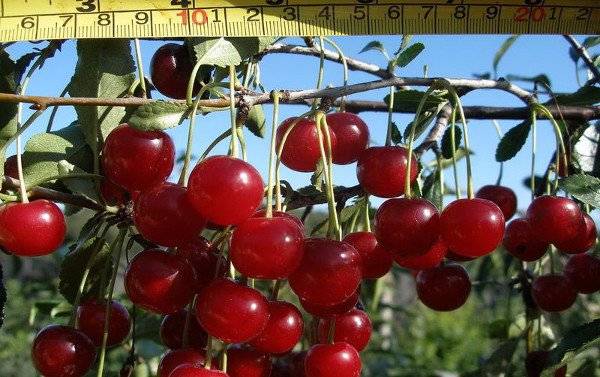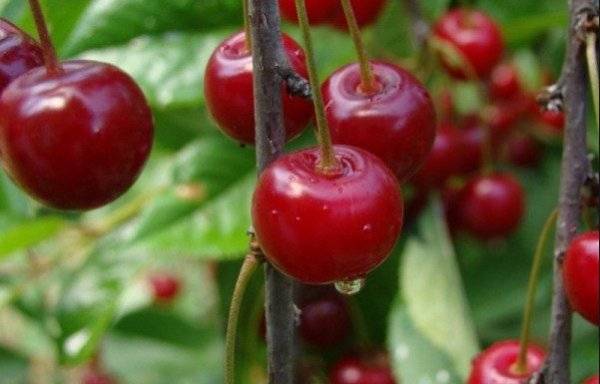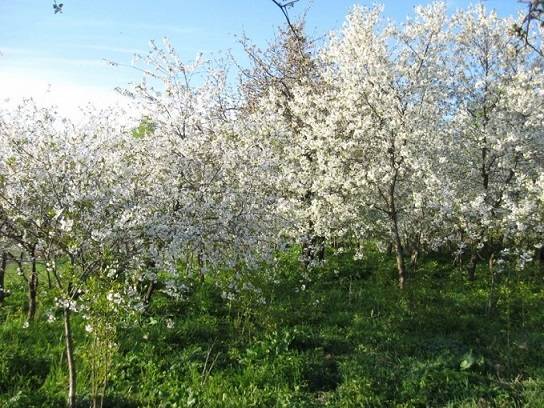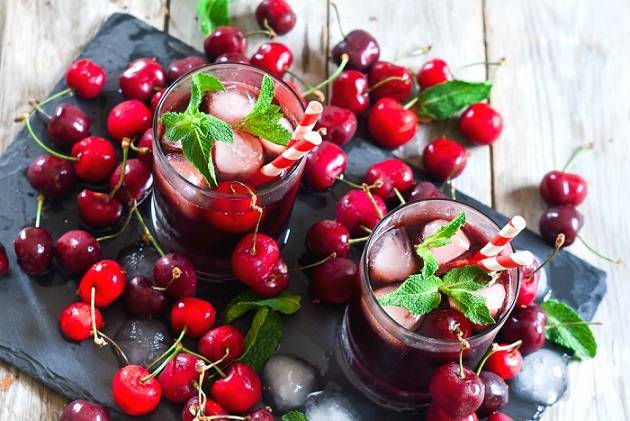Content
Nature is generous with amazing gifts, so the Generous cherry was received from her by gardeners as a gift, it was not without human participation, people did not leave this gift unattended and made many amateur gardeners know about it. This cherry fully justifies its name, generously giving its fruits to caring garden workers.
Breeding history
Cherry Maksimovskaya (Generous) is the result of natural pollination of a seedling of the famous Ideal cherry variety and several other varieties. In 1959, the Sverdlovsk breeders S. Zhukov and N. Gvozdyukova isolated the resulting variety as a separate crop, it was registered in the State Register in 1985 and zoned in the West Siberian region. In the future, Maksimovskaya cherry became widespread in Russia, Ukraine, Belarus and the Baltic countries.
Plant morphology
For the successful cultivation of cherries, you need to know the structural features of the culture. The morphology for all varieties of this plant is the same, there are only small deviations, namely in the cherry of the Maksimovskaya variety:
- cherry roots are the core system. Its main root reaches a depth of 1.5 to 2.5 meters, so the plant is not afraid of a lack of moisture. Accessory root processes are located throughout the rod, the ones closest to the surface are at a depth of 10-20 cm. When loosening, this must be taken into account so as not to damage them;
- aerial part - formed in the form of a tree with one main trunk or a shrub with several perennial shoots;
- leaves - petiolate, saturated green, jagged edges;
- the fruits of Maksimovskaya are round shiny berries, which consist of a stone covered with a shell of juicy pulp, the larger the diameter of the berry, the easier the seeds are separated during peeling. The skin color is red.
Description of culture
For many years this wonderful plant gives its fruits to people, each time surprising with its generosity. Novice gardeners will also be interested to know how this culture differs from other varieties, what characteristics the Schedraya cherry variety is famous for.
Cherry Maksimovskaya is a perennial fruit tree or shrub that has long settled in the individual gardens of many cherry lovers and in the vast territories of fruit and berry agricultural firms. Due to its high yield and many more of its qualities, it has earned the love of gardeners from different countries.
Photo of a flowering cherry tree of the Generous variety:
Cherry Maksimovskaya (Generous) reaches a height of 1.5 meters, branches of average density in volume, the crown is compact, easy to harvest, the average life cycle is up to 35 years with proper care and attention.
Maksimovskaya cherry fruits are smooth and shiny, juicy, sweet and sour taste (good and excellent). The weight of one berry is on average 4.2 g.
This culture is very winter-hardy and drought-resistant. Growing Generous Cherries is possible both in the southern regions and in colder climates: in Siberia, the Urals, and the Volga region.
Characteristics
Let us consider in more detail other characteristic features of the Generous (Maksimovskaya) cherry.
Drought tolerance
In addition to natural moisture in the form of rain, the plant is watered 3 times per season: during flowering, during fruit ripening and after harvest. In case of persistent drought, watering is carried out additionally, young seedlings require more frequent watering (up to 5 times).
Winter hardiness
Cherries are able to withstand temperatures as low as -45 ° C without any damage or additional cover.
Pollination
This culture, according to the State Register, is partially self-fertile, that is, the tree independently forms from 7 to 20% of ovaries, but to increase the yield and quality of fruits, it needs pollinating plants. For Shchedroi cherries, these can be varieties that bloom at the same time as Maksimovskaya: Lyubskaya, Malinovka, Polevka and Subbotinskaya.
Flowering period
Cherry Maksimovskaya begins to bloom in late May or early June, depending on the region and weather conditions.
Ripening terms, yield
Fruit ripening also depends on the climatic conditions of the region where the Maksimovskaya cherry grows, for the Moscow region, the Urals or the Volga region - this is August-September. The average harvest of Maksimovskaya cherry is 10-15 kg per adult plant per season.
Fruiting period
The ripening period for Shchedroi cherries is greatly extended, the berries do not ripen at the same time, from July to September. Harvesting takes place in 2-3 stages.
Scope of berries
Cherry fruits are consumed both fresh and in various processed products: juices, preserves, wines and jams.
Pest and disease resistance
The resistance of Shchedrai or Maksimovskaya cherries to clasterosporium is noted. The main pests are cherry aphids and slimy sawflies.
Advantages and disadvantages
For a long time of its existence, the Maksimovskaya cherry variety (Stepnaya, Generous) has shown itself not only on the good side, but some shortcomings have been identified by gardeners.
Pros:
- compactness of the crown - ease of care and picking berries;
- unpretentiousness - good condition in case of frost and satisfactory in case of drought;
- high yield, excellent taste of berries, versatility of their use.
Minuses:
- extended period of fruit ripening;
- weak resistance to fungal diseases.
Landing features
One or two-year-old seedlings are purchased in the fall and buried in trenches up to 30 cm deep, leaving a small upper part of 10-15 cm on the surface. In April, the seedlings are taken out of the shelter and assigned to a permanent place.
Recommended timing
For stone fruit crops, to which the Maksimovskaya cherry belongs, the best option is spring planting. Planting time is April, when the buds have not yet blossomed.
Choosing the right place
Generous (Maksimovskaya) cherry loves areas well lit by the sun; it should be planted on the south or southwest side of the garden. Low-lying, swampy and windswept places are not at all suitable for this plant.
What crops can and cannot be planted nearby
When choosing a place for cherries, you need to take into account the positive and negative effects of neighboring plants on the growing season of this crop. Cherry trees and bushes should not be planted next to tall apple trees that will shade the cherry. Good neighbors will be: cherry (helps in pollination), mountain ash, grapes or elderberry (protects against aphids). Under cherry bushes, you cannot sow and plant vegetables of the nightshade family: tomatoes, potatoes, peppers and eggplants.
Selection and preparation of planting material
For planting Maksimovskaya, one or two-year-old seedlings with a well-developed root system, with buds that have not yet begun to grow, are chosen.
Landing algorithm
When planting Maksimovskaya cherry seedlings, the main attention should be paid to the following points:
- The planting hole is prepared in advance, 2-3 weeks before planting the plant, or in the autumn.
- Hole size 40x40 cm, depth up to 50 cm.
- Distance from the nearest trees: tall (apple tree) - at least 5 meters, medium and low in growth - about 2-3 meters.
- The planting hole is filled with compost to ½ the depth, the necessary mineral fertilizers are added, the soil is mixed, and a seedling is placed in the hole.
- Sprinkle the plant with the top layer of fertile soil, then fill up the bottom, taken out of the hole when digging up the soil. Water the seedlings, slightly compact the soil, mulch with peat or tree bark.
Follow-up care of the culture
Cherry pruning is done in the spring, when the buds on the tree have not yet woken up. It is necessary to trim excess and damaged branches in order to form the crown, reduce the density inside the bush and to increase productivity.
For the winter, frost-resistant Generous (Maksimovskaya) does not need to be sheltered, it is only necessary to provide for the protection of branches from hares and other rodents, if such pests are present.
The first 2-3 years before the start of active fruiting, plant feeding is not required. From the third year, the culture must be regularly fed with complex fertilizers and organic matter must be applied annually.
Diseases and pests, methods of control and prevention
Protection against diseases and pests is the implementation of mandatory preventive spring treatments of cherries with fungicides: Bordeaux mixture, copper and iron vitriol.
For pests (aphids, sawflies), plants are sprayed with special solutions: karbofos, Fitoverma, Nitra.
The number of new varieties of cherries is growing every year, but Maksimovskaya successfully withstands the competition, constantly confirming its name - Generous, does not skimp on a bountiful annual harvest, does not give gardeners problems with diseases, gives people tasty and juicy fruits.












